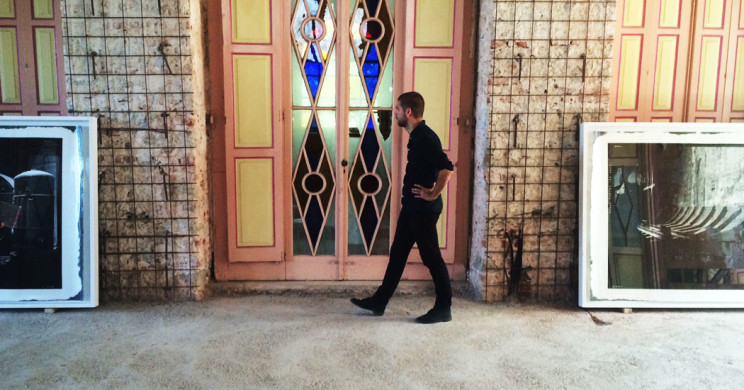BY NOELLE BODICK | Blouinartinfo.com
ISTANBUL — Following the bloody breakdown between the Turkish government and Kurdistan Workers’ Party (PKK), a few participants in the Istanbul Biennial proposed that artists briefly suspend their work in the citywide exhibition that opens to the public on September 5. On Wednesday, curator Carolyn Christov-Bakargiev, who was copied on the emailed proposal to the artists in “Saltwater: A Theory of Thought Forms,” appeared unruffled by the action.
“I believe there is a very strong agency in those individual gestures and acts. Whether I think that it will have a true impact on what is going on and the Machiavellian deals that are being made behind the scenes is another question,” she said at the press conference held at the Italian High School on Istanbul’s Bogazkesen Street. “I am a skeptic in human affairs.”
It was a diplomatic enough answer to an arts press corps bracing themselves for a follow-up to her fouled Documenta Q&A session in 2012. Christov-Bakargiev then paused, looked up into the shady canopy in the courtyard, and serenely added: “That is why I am interested in the oak trees.”
For the 14th Istanbul Biennial, Christov-Bakargiev has “drafted” (the choice term she insists on rather than “curated” or “selected”) an exhibition that at times feels like an embrace of occult spiritualist revivalism. Or, from the perspective of a journalist on a stopover, a crunchy, return-to-nature overnight camp. (Even the show’s catalogue has the chunky heft of a Gideon Bible, a kind of “Gospel According to CCB.”) It also happens to be a brilliant curatorial conceit, suggesting the retreated position of intellectuals today.
After a few more questions, she welcomed three artists to the stage for a surreal art-world “Kumbaya” moment. Theaster Gates first sang in a rich baritone, then Adrian Villar Rojas strummed his guitar, crooning a love ballad in a falsetto. Meanwhile, Liam Gillick stared at a drum set (he seemed only to be manipulating a synthesizer). Christov-Bakargiev swayed to the weird trio in her seat, wearing a feather-tufted sleeveless cassock like a high priestess.
Like all dutiful initiates, patrons accepted a common mark during the biennial’s opening days: temporary tattoos designed by Lawrence Weiner, reading “ON THE VERGE.” Trips to the Büyükada Island in the Sea of Marmara — the island where Leon Trotsky was exiled for four years prior to going to Mexico via France — felt like pilgrimages. Theaster Gates lead boat trips on the Bosphorous at 6:30 in the morning. Pierre Huyghe built a concrete stage at the bottom of the Marmara sea, off Sivriada, for jellyfish and other sea creatures. Go to the coordinates and you will stare only at the waves. Of the biennial’s 36 locations in and around Istanbul, three are fictional.
Then there is of course the talk of saltwater (the title of the biennial) and its healing powers. As many of the works in the show are in remote and isolated venues across city and sea, one can regress into thinking that the only saltwater that the curator had drawn forth was the sweat on your back. Many works are in hotels (William Kentridge), basements (Janet Cardiff and George Bures Miller), abandoned houses (Ed Atkins, Susan Philipsz), or in an Old City Turkish bath (Wael Shawky).
Abstract, stubborn, and hard to access: what might fail a travel bureau is a boon to this biennial. “It occurred to me that the agora of today may not be in the public square, or park, but possibly in the freer retreat of an anonymous house on Buyukada, or in a hotel room, camping or waiting for what is to come, if properly wired and connected to others,” Christov-Bakargiev writes in her catalogue.
Some artists have eschewed physicality altogether: Haig Aivazian’s Holy Trinity Armenian Church chorus, the symbols and mallets of Andrew Yang’s attic, the clicking of Cevdet Erek’s sound installation in a garage destined for demolition, the disembodied voices spoken in the pitch black room by Irena Haiduk.
In Francis Alÿs’s film staged at the 1920s tobacco warehouse DEPO, dozens of children with birdcall whistles tweet and sing across the ruins of an old city between Turkey and Armenia. They are calling back the birds to the ghostly plot of land, the film says.
On Friday, outside of the exhibition space, the lanky, gentle-looking artist Alÿs sat pretzel-legged on a sunny ledge. He was found writing and sketching on a postcard: alone, and intent on his work.
The 14th Istanbul Biennial opens to the public on September 5 and runs through November.
























